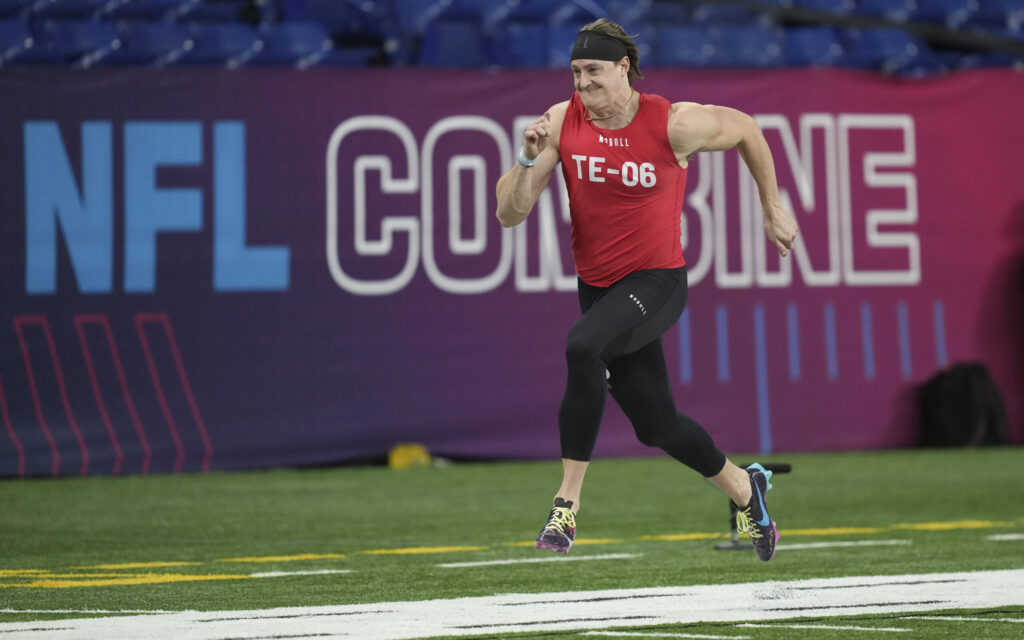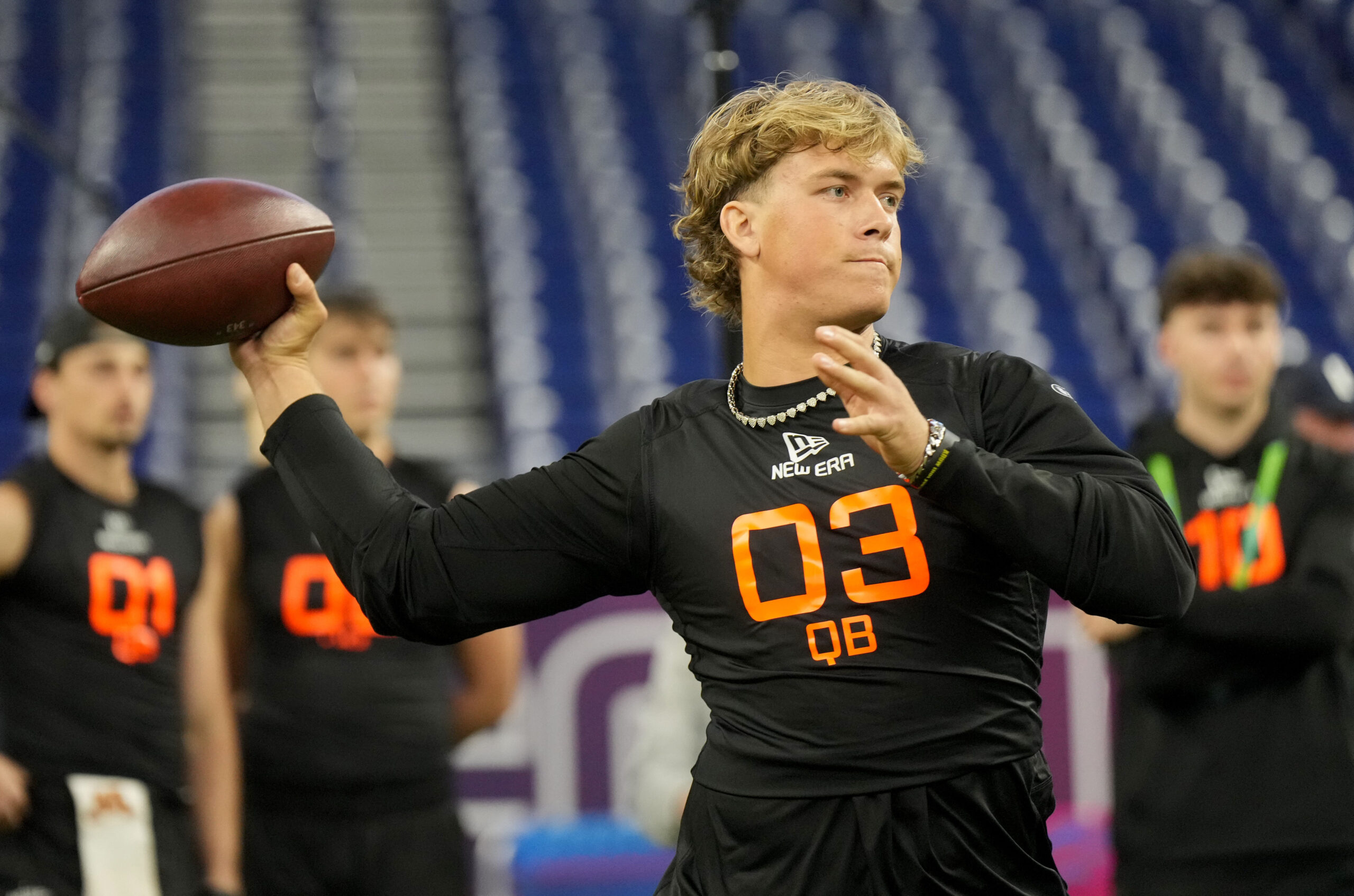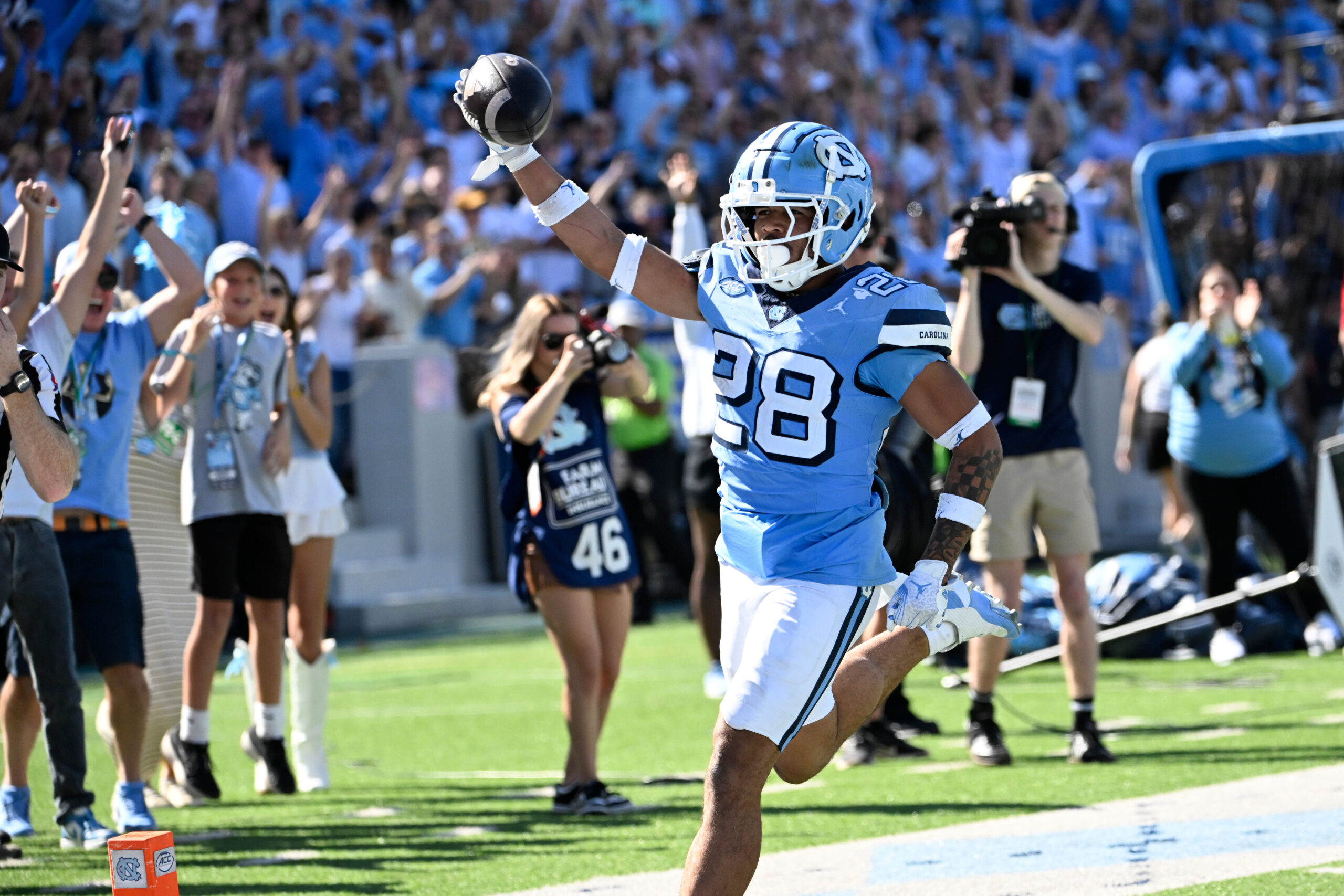Analysis
4/14/23
7 min read
2023 NFL Draft: Analyzing Tight Ends With Round 2 Draft Capital

Since 2010, eight rookie tight ends have scored 10 or more points per reception per game (PPR/G) in more than five games played. The most recent trio includes Pat Freiermuth, Evan Engram and Kyle Pitts. If we lower the threshold to five games of 10 PPR, then a couple of 2022 tight end prospects jump in. Greg Dulcich and Chigoziem Okonkwo totaled five games of 10 PPR along with older names like Chris Herndon and OJ Howard.
When we narrow our search to first-round tight end prospects, only Engram, Pitts and Howard make the list. Freiermuth, Hunter Henry and Rob Gronkowski enter the grouping when adding second-rounders. Dulcich, Jordan Reed, Jimmy Graham and Tony Moeaki went in the third round of the NFL Draft, making it a relatively well-known list.
Other notable tight end prospects that reached the arbitrary 10 PPR/G mark in three or more games with Rounds 1-3 capital, include Dallas Goedert, Jermaine Gresham, Noah Fant and David Njoku. So what's the point? Notably, draft capital may mean less with tight end prospects and shouldn't be weighted as heavily in our evaluation. While using 10 PPR/G feels arbitrary, it's usually what the top 8-12 at the position average in a given season.
>> READ: Top 3 Running Back Prospect Profiles
Like with the running back prospects, we'll look at the underlying metrics to paint a clearer picture of these tight end prospects. How do these prospects compare to past players from a production standpoint? Do they have standout skills? We hope to answer those questions about three tight ends with second-round projected capital and a fourth with elite athleticism.
 Sam LaPorta, TE, Iowa
Sam LaPorta, TE, Iowa
One could argue Iowa always spits out fantasy-relevant tight end prospects with T.J. Hockenson, Fant, and George Kittle as the most notable names. Like those fellow alumni, Sam LaPorta (scouting report) has good size-adjusted athleticism. LaPorta is listed at 6-foot-4, 245 pounds, and ran a 4.59 40-yard dash (91st percentile). That translated into an 88th-percentile Speed Score, with a near-elite Freak Score (84th percentile) and Explosion Score (86th percentile).
From a production standpoint, LaPorta nearly matched Michael Mayer's (scouting report) career receiving yardage market share (25 percent vs. 24 percent). The same occurred in 2022 with LaPorta at 35 percent and Mayer at 34 percent. We note that because Mayer projects as a first-round pick and the No. 1 tight end prospect. Meanwhile, LaPorta projects to go in Round 2.
When we add in projected second-round draft capital and speed, LaPorta compares favorably to Dulcich and Trey McBride. Dulcich and McBride are fair comparisons since both provided fantasy-viable production in Year 1.
McBride finished at Colorado State with off-the-chart production via 131 targets (No. 1), 2.9 yards per route run (YPRR) (No. 5) and 93.7 receiving yards per game (No. 1). For context, McBride totaled the most receiving yards (1,124) since 2016 per Sports Info Solutions, and only one other tight end reached 1,000 receiving yards with Harrison Bryant at 1,004 in 2019. There's probably an argument to discount their college production since they didn't come from a Power 5 Conference.
Meanwhile, Dulcich posted 2.1 YPRR (No. 23), yet some uber-efficiency on a per-target basis with 10.8 YPT (No. 11) in 2021. Moving on to LaPorta, in 2022, he ranked fourth in targets (92) with the 16th-best YPRR (2.3). However, he ranked 72nd in yards per target (7.1) out of 118 qualified tight ends with a minimum of 25 targets.
Early 2023 Outlook
As noted earlier, it's rare to find a tight end prospect that produces immediately in Year 1. LaPorta checks the production and athleticism boxes, making him a tight end sleeper option in redraft and dynasty formats. The likely scenario involves LaPorta producing as a backend TE1 in Year 1, though the threshold of 10 PPR/G isn't a high bar.
[bc_video video_id="6323560410112" account_id="6312875271001" player_id="default" embed="in-page" padding_top="56%" autoplay="" min_width="0px" playsinline="playsinline" picture_in_picture="" language_detection="" application_id="" max_width="680px" mute="muted" width="100%" height="100%" aspect_ratio="16:9" sizing="responsive" ]
 Luke Musgrave, TE, Oregon State
Luke Musgrave, TE, Oregon State
NFL Scouts and Evaluators seem to like Luke Musgrave (scouting report) with the projected second-round draft capital. That alone should pique our interest, though he barely produced in college. As a junior, Musgrave peaked with a 17 percent Receiving Yard Market Share (RecYdMS) and 14 percent Receiving Dominator. Unfortunately, Musgrave suffered a knee injury that ended his senior season before he could build on those numbers. The table below shows the top 12 tight ends sorted by RecYdMS with an arbitrary number of two games played.
Musgrave had 11 receptions and 169 receiving yards in 2022, translating into a 33 percent Receiving Dominator in the small sample. If that pace remained steady, Musgrave would've matched Mayer, LaPorta and Dalton Kincaid (scouting report). Musgrave seemed healthy at the NFL Combine with near-elite workout measures.
Musgrave ran a 4.61 40-yard dash (89th percentile), leading to a 91st percentile Speed Score. He also posted a 93rd percentile Freak and Explosion Score matching some of the other high-end tight end prospects in the 2023 class. When we lower the target threshold to 10, Musgrave ranks first in YPRR (3.5) and eighth in YPT (11.3). We could've witnessed a breakout season for Musgrave as a senior.
Early 2023 Outlook
Sure, there's a bit of projection with Musgrave in the NFL. But his above-average workout metrics and per-game numbers as a senior provide us with an optimistic view. Some interesting comparable players pop up with similar athleticism, including Daniel Bellinger, Travis Kelce, Tyler Eifert, and Dawson Knox. Based on the landing spot, Musgrave looks like a sneaky option to take in the third or fourth round of rookie drafts, with backend TE1 potential as a rookie.
 Darnell Washington, TE, Georgia
Darnell Washington, TE, Georgia
Darnell Washington (scouting report) is one of the final tight end prospects we'll cover with second-round draft capital. Listed at 6-foot-7, 265 pounds, he's another athletic outlier with elite lateral quickness, evidenced by a 4.08 shuttle (99th percentile). Washington is the heaviest tight end prospect, yet boasts a 93rd percentile Speed Score and 95th percentile Explosion Score. That's eye-popping size-adjusted athleticism.
At Georgia, Washington shared receiving opportunities with Brock Bowers, a future tight end prospect. Bowers nearly doubled Washington's production in 2022, so the nine percent RecYdMS for Washington doesn't inspire confidence. Washington's closest comparisons from a production, size and speed standpoint include few drafted players. When we project second-round draft capital, Washington's comparables include Nick Vannett, Dalton Keene, Drew Sample and Cole Kmet since 2012. Sample and Kmet look like reasonable comps given the draft capital, with Kmet being a consistent fantasy sleeper.
Early 2023 Outlook
From a real-life standpoint, Washington ranked fourth in Points Earned in run blocking but ranked 107th in pass blocking per Sports Info Solutions. With that in mind, Washington might be closer to Sample in the NFL, with blocking as a strength and receiving a little behind.
Washington grades better from a pass-blocking standpoint than Mayer and Kincaid, though Mayer ranked seventh in Points Earned in run blocking. There's a scenario where Washington earns reps as a run blocker and then displays his athleticism as a receiver in an efficient role.
 Zack Kuntz, TE, Old Dominion
Zack Kuntz, TE, Old Dominion
If you like small school players with elite athleticism, let's look at Zack Kuntz (scouting report) out of Old Dominion. Before coming to ODU, he played at Penn State for a couple of seasons but hardly saw playing time with only five receptions. The most notable NFL players from ODU include Zach Pascal, Taylor Heinicke and Travis Fulgham. While that list doesn't inspire confidence, Kuntz falls into the uber-athleticism bucket similar to Mike Gesicki, Fant or Howard, though without the Power 5 Conference piece.
Listed at 6-foot-7, 255 pounds, Kuntz peaked as a junior in 2021 with a 25 percent RecYdMS and a 30 percent Receiving Dominator. Unfortunately, Kuntz suffered an injury in 2022, ending his season. Still, Kuntz ranked in the 96th percentile in Speed Score and the 98th percentile in Freak and Explosion Score after his combine performance.
Early 2023 Outlook
It's hard to find close comparisons for Kuntz other than Kylen Granson, though Kuntz boasts better size and speed. Kuntz projects to go in the fourth round, and his performance at the NFL Combine probably improved his stock. Look to draft Kuntz in the fourth round of dynasty rookie drafts, with the athletic upside to be a consideration in the third.











